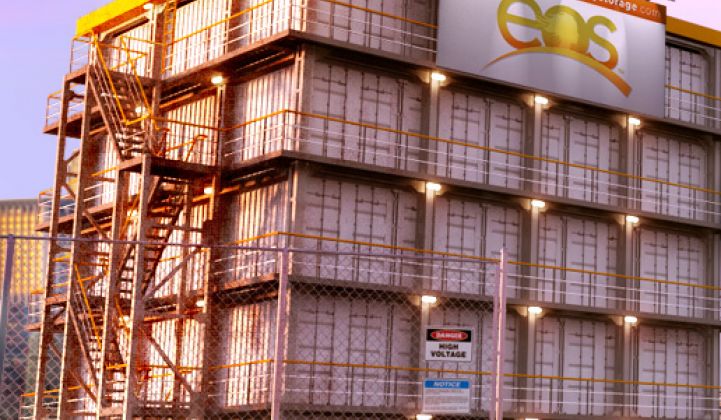Eos Energy Storage has raised the first $15 million of a planned $25 million in funding, meant to scale up manufacturing of its hybrid zinc cathode, aqueous electrolyte-based battery that could break the price barrier for grid-scale, multi-hour energy storage.
The New York-based startup announced Monday that it expects to raise $15 million from a private placement with previous investor AltEnergy LLC, and raise an additional $10 million with accredited investors this quarter to reach its $25 million target. Eos has previously raised about $27 million in two funding rounds from investors including AltEnergy, NRG Energy and Fisher Brothers.
The new investment will help Eos scale up manufacturing of its Aurora batteries, which promise 75 percent round-trip efficiency, along with a 10,000-cycle, or 30-year, lifetime, at a price point of $160 per kilowatt-hour. That’s much lower than even the cheapest competing lithium-ion battery grid storage systems.
Getting from lab tests to real-world deployments is the next critical step for Eos, starting at the Ithaca, N.Y. headquarters of contract manufacturing partner Incodema. That’s where Eos has been building prototype batteries for testing with utility partners such as Consolidated Edison, GDF Suez and Pacific Gas & Electric.
Eos will use the new money to bring that line up to what Philippe Bouchard, business development manager, described as a “megawatt-per-month production capability” over the course of the year. The startup will deliver about 1 megawatt of its DC battery systems in 2015, he said.
But “Eos’ business strategy is not to become a large global manufacturer of this technology,” he said. “There are other manufacturers better suited to that task.” To that end, the startup is in discussions with what he described as some of the “largest contracts manufacturers in the world,” in search of partners willing to replicate its production lines, and help it to reach its goal of 100 megawatts of annual capacity in 2016.
“We want to work with existing manufacturers, and we’ve designed the battery to employ highly commoditized manufacturing equipment and processes,” he said. “We’re talking about metal cutting and stamping for our current collectors; our cathode is made by mixing and pressing carbon powders and other active ingredients; our electrolyte is a simple water-based solution; and we’re packaging these cells in plastic mold-injection frames. […] There are no clean rooms required, no complex vapor deposition processes. We’re building batteries in the equivalent of a machine shop.”
That covers the manufacturing side of cost-cutting. On the ingredient side, zinc is one of the most abundant metals on earth, and much cheaper than lithium. That’s made it a key ingredient in many non-rechargeable batteries. But it’s a challenge to make rechargeable batteries that don’t quickly break down due to electrode corrosion and buildup. Eos has solved that using a proprietary coating that creates a “permanently conductive and non-corrosive surface,” Bouchard said.
So far, Eos has built prototype batteries in the kilowatt-hour scale, the first of which, a 36 kilowatt-hour system, is being tested by hometown utility Con Ed. Eos is shipping its first test unit to French energy and water giant GDF Suez for testing in Europe, Bouchard said. And last month, the California Energy Commission awarded PG&E a $2.2 million grant to test the startup’s batteries in conjunction with operating software from behind-the-meter battery startup Stem.
These and other utilities are testing Eos batteries as part of the startup’s Genesis Program, which launched in 2013. Later this month, the company will announce its Aegis Program, which will bring systems integrators, power electronics manufacturers and other grid energy storage companies into the picture, Bouchard said.
Eventually, Eos wants to produce 1-megawatt, 4-megawatt-hour containerized systems that come ready to be connected to the grid, he said. “We want to provide the lowest-cost DC battery system on the market, so we can then work with multiple integrators and distributors to provide an AC solution at the lowest possible cost. The Aegis Program, and the partners we intend to announce in the coming months, will really expand our capabilities.”
Eos is far from the only startup bringing low-cost battery technologies to market, of course. Aquion Energy has raised more than $150 million in equity, debt and grant financing and is set to deploy more than a megawatt this year of its sodium-ion batteries, targeting a price point of $300 per kilowatt-hour. Flow batteries from Imergy, UniEnergy Technologies, CellCube-American Vanadium and ViZn Energy are targeting similarly low price points. All of them are also better suited to multi-hour energy storage applications than are lithium-ion batteries.
At the same time, lithium-ion batteries are continuing to fall in price, and manufacturers like Panasonic, Mitsubishi, LG Chem, Samsung, Saft and A123 owner NEC are targeting grid storage as a major new market. Tesla Motors, which is building a $5 billion Giga factory in Nevada to churn out both vehicle and grid-scale batteries, is using Panasonic's lithium-ion cells, and AES Energy Storage, which has deployed the most grid batteries in the United States, has named lithium-ion the chemistry of choice for the rest of the decade.



